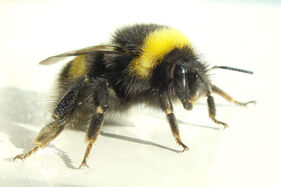AuthorLyn Chimera is a Master Gardener, consultant and lecturer. Archives
May 2023
Categories |
Back to Blog
February 27th, 20222/27/2022  The Amazing Bumblebee By Lyn Chimera Recently I was asked to compile some interesting information about bumblebees, in the genus Bombus, for an informational flyer Master Gardeners could use as a handout at various events like Plantasia (March, 16-20). They are such fascinating little critters I wanted to share some of what I learned. First of all, Bumblebees are large (about an inch) yellow and black flying insects native to the US. They have 4 wings. The two rear wings are smaller than the front wings and the wings beat at a rate of 130-240 beats per second. There are about 46 varieties of bumblebees in N America and over 250 known varieties worldwide. Bumblebees are our only native bee that lives in colonies. They prefer to live in cavities like dead trees and abandoned nests. Their favorite nesting site, however, is an abandoned rodent tunnel because it’s warm and already lined with fur. Sounds cozy to me. Their colonies range in number from 50 to 500. Bumblebees only live for one year. In the fall new queens are hatched and spend the winter in a protected area then start new colonies in the spring. Because the bumblebees don’t overwinter, they don’t need to store food. The nectar and pollen they gather goes to feed themselves and their young. As pollinators go bumblers are much more efficient than honeybees. This is due in part to their hairy bodies which spread the pollen more effectively. They also “buzz pollinate” which means they vibrate their bodies as they come in contact with a flower to cause even more pollen distribution. One of the most interesting facts about their pollination is they leave a scent marking on each flower they pollinate. This alerts other bumblers that the flower had been pollinated so go on to another. How efficient! The reason they are so favored by agriculture and nature is that they are generalists rather than specialists. Bumblers will gather from a variety of species at the same time. In addition, due to their built in “fur coat” they can fly and pollinate earlier in the spring and later in the fall than many other pollinating insects. They also have an amazing tongue that is often longer than a honeybee’s so they can get nectar from a wider variety of flowers. By the way their tongue is also their sense organ for taste and smell. Worker bumblebees have the job of gathering nectar for carbohydrates and pollen for protein. They are real workhorses flying a mile or further to gather food. The average worker carries 25% of their body weight in pollen and nectar. Some have been measured to carry 75% of their body weight. That would be like a 150 pound person carrying 37.5 lbs. or up to 122 lbs.! Now that’s impressive. I must admit I love watching bumblebees in my garden. They won’t sting unless threatened so are safe to watch form close up. Often you will find one in the early morning sleeping on a flower. Honeybees will do this as well. In my garden native turtle head (Chelone obliqua) is one of their favorite flowers. Because of the shape of the flower the bumbler has to wiggle its way into the petals to get to the pollen and nectar. Always entertaining to watch. What can you do to help protect bumblebees and basically all pollinators? Plant a variety of native and pollinator attracting flowers covering a span of seasons and encourage neighbors to do the same. Destruction of habitat is one of the contributing factors in the demise of bumblebees. Avoid using pesticides particularly the systematic ones that persist throughout the plant. These toxins effect the whole plant including the pollen and nectar and kill all insects including pollinators. Not using pesticides and herbicides is one of the best ways any home gardener can help the ecology. Never harm a bumblebee; they are our friends.
0 Comments
Read More
Leave a Reply. |

 RSS Feed
RSS Feed
